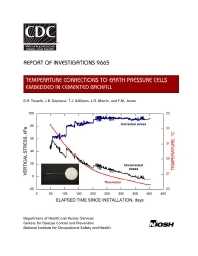Mining Publication: Temperature Corrections to Earth Pressure Cells Embedded in Backfill
Original creation date: April 2006
Determining backfill stress is an important part of evaluating mine safety, whether personnel are working in proximity to backfill or in other areas of the mine where backfill is an integral part of regional support. To assist in determining stress in backfill more accurately, researchers from the NIOSH Spokane Research Laboratory, Placer Dome, Inc. (Turquoise Ridge Mine), Peabody Energy Co. (Foidel Creek Mine), and Hecla Mining Co. (Lucky Friday Mine) used temperature readings recorded by thermistors to correct for the influence of temperature on stress data. These thermistors were positioned in the stems of earth pressure cells installed in backfill. Corrections were then calculated and compared using four different methods: polynomial equations fit to temperature-versus-stress plots before the pressure cells were loaded by overburden, a factor provided by the manufacturer, a theoretically derived factor, and a linear correction factor based on information collected during periods when no mining was taking place. To evaluate the accuracy of these methods, corrected stresses were calculated using each method and results compared to cumulative stresses caused by blasting at one of the mines. Results indicated that only a small percentage of the temperature effect on stress was corrected using the factor from the manufacturer because that factor accounted for only the pressure transducer and not the entire instrument body. Stresses adjusted with a linear correction factor based on information collected during periods when no mining was taking place were the most accurate. Stresses recorded at two other mines were corrected using the theoretical method and the polynomial equations method; the two methods produced similar results. For some time intervals, the results were identical.
Authors: DR Tesarik, JB Seymour, TJ Williams, LA Martin, FM Jones
Report of Investigations - April 2006
NIOSHTIC2 Number: 20030064
U.S. Department of Health and Human Services, National Institute for Occupational Safety and Health, DHHS (NIOSH) Publication No. 2006-103, Report of Investigations 9665, Spokane, WA, 2006; April :1-34
See Also
- Blast Wave Propagation in Underground Mines
- The Critical Ventilation Velocity in Tunnel Fires - A Computer Simulation
- Explosion Pressure Design Criteria for New Seals in U.S. Coal Mines
- A Gas Pressure-Based Drift Round Blast Design Methodology
- In-depth Survey Report: Control Technology for Environmental Enclosures - The Effect of Wind Speed Upon Aerosol Penetration Into an Enclosure at Clean Air Filter, Defiance, IA
- Investigation of Ampacity Derating Factors for Shuttle Cars Using Fiber Optics Technology
- Low Temperature Limits for Mixing Recycled Oil, Diesel Fuel, and Ammonium Nitrate to Make ANFO-Type Blasting Agents
- Methane Diffusion Parameters for Sized Coal Particles: A Measuring Apparatus and Some Preliminary Results
- The NIOSH Shield Hydraulics Inspection and Evaluation of Leg Data (Shield) Computer Program
- Tying Acceleration and GPS Location Information Together To Create a Mine Management Tool
- Content source: National Institute for Occupational Safety and Health, Mining Program


 ShareCompartir
ShareCompartir
